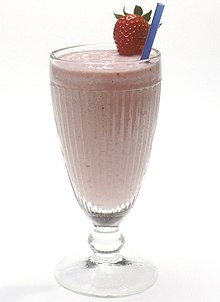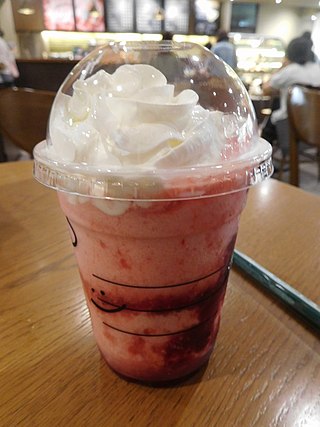
Frappuccino is a line of blended iced coffee drinks sold by Starbucks. It may consist of coffee or crème base, blended with ice and ingredients such as flavored syrups and usually topped with whipped cream and or spices. It may also include blended Starbucks refreshers. Frappuccinos are also sold as bottled coffee beverages in grocery stores, convenience stores and from vending machines.

Ovaltine is a brand of milk flavoring product made with malt extract, sugar, and whey. Some flavors also have cocoa. Ovaltine, a registered trademark of Associated British Foods, is made by Wander AG, a subsidiary of Twinings, which acquired the brand from Novartis in 2002, except in the United States, where Nestlé acquired the rights separately from Novartis in the late 2000s.

Cream soda is a sweet soft drink. Generally flavored with vanilla and based on the taste of an ice cream float, a wide range of variations can be found worldwide.
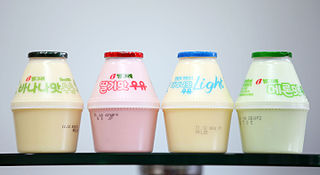
Flavored milk is a sweetened dairy drink made with milk, sugar, flavorings, and sometimes food colorings. It may be sold as a pasteurized, refrigerated product, or as an ultra-high-temperature (UHT) treated product not requiring refrigeration. It may also be made in restaurants or homes by mixing flavorings into milk.

Malted milk or malt powder is a powder made from a mixture of malted barley, wheat flour, and evaporated whole milk powder. The powder is used to add its distinctive flavor to beverages and other foods, but it is also used in baking to help dough cook properly.

Coffee milk is a drink made by mixing coffee syrup or extract with milk, in a manner similar to chocolate milk. Since 1993, it has been the official state drink of the U.S. state of Rhode Island.
A coffee cabinet is an ice cream-based milkshake found almost exclusively in Rhode Island consisting of coffee ice cream, coffee syrup, and milk. The ingredients are mixed in a drink blender or milkshake blender.

Soda jerk is an American term used to refer to a person — typically a young man — who would operate the soda fountain in a drugstore, preparing and serving soda drinks and ice cream sodas. The drinks were made by mixing flavored syrup, carbonated water, and occasionally malt powder over either ice or a few scoops of ice cream. The drink would then be served in a tall glass with a long-handled spoon, most commonly known as a "soda spoon", and drinking straws.
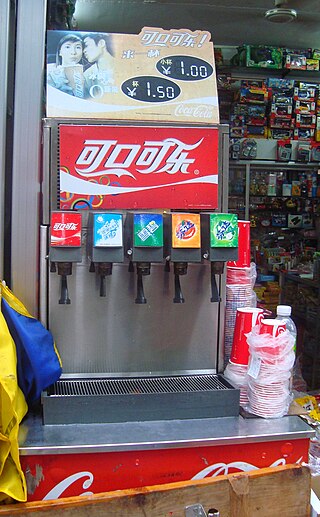
A soda fountain is a device that dispenses carbonated soft drinks, called fountain drinks. They can be found in restaurants, concession stands and other locations such as convenience stores. The artifact combines flavored syrup or syrup concentrate and carbon dioxide with chilled and purified water to make soft drinks, either manually, or in a vending machine which is essentially an automated soda fountain that is operated using a soda gun. Today, the syrup often is pumped from a special container called a bag-in-box (BiB).

An ice cream float or ice cream soda, also known as a spider in Australia and New Zealand, is a chilled beverage that consists of ice cream in either a soft drink or a mixture of flavored syrup and carbonated water.

Chocolate syrup is a sweet, chocolate-flavored condiment. It is often used as a topping or dessert sauce for various desserts, such as ice cream, or mixed with milk to make chocolate milk or blended with milk and ice cream to make a chocolate milkshake. Chocolate syrup is sold in a variety of consistencies, ranging from a thin liquid that can be drizzled from a bottle to a thick sauce that needs to be spooned onto the dessert item.

The Shamrock Shake is a seasonal green mint flavored milkshake dessert sold at some McDonald's restaurants during March to celebrate St. Patrick's Day in the US, Canada and Ireland.

A slushy is a type of beverage made of flavored ice and a drink, similar to granitas but with a more liquid composition. It is also commonly called a slush, slurpee, frozen beverage, or frozen drink. A slushie can either be carbonated or non-carbonated; the carbonated version is sometimes called a frozen carbonated drink or frozen carbonated beverage.

Chocolate ice cream is ice cream with natural or artificial chocolate flavoring. One of the oldest flavors of ice creams, it is also one of the world's most popular. While most often sold alone, it is also a base for many other flavors.
Flavored syrups typically consist of a simple syrup, that is sugar, with naturally occurring or artificial (synthesized) flavorings also dissolved in them. A sugar substitute may also be used.

A smoothie is a beverage made by puréeing ingredients in a blender. A smoothie commonly has a liquid base, such as fruit juice or milk, yogurt or ice cream. Other ingredients may be added, including fruits, vegetables, non-dairy milk, crushed ice, whey powder or nutritional supplements.

Coca-Cola Freestyle is a touch screen soda fountain introduced by The Coca-Cola Company in 2009. The machine features 165 different Coca-Cola drink products, as well as custom flavors. The machine allows users to select from mixtures of flavors of Coca-Cola branded products which are then individually dispensed. The machines are currently located in major Coca-Cola partners and retail locations as a part of a gradual and ongoing deployment.

Nesquik is a brand of food products made by Swiss company Nestlé. In 1948, Nestlé launched a drink mix for chocolate-flavored milk called Nestlé Quik in the United States; this was released in Europe during the 1950s as Nesquik.

A milkshake machine or drink mixer is a kind of countertop electric mixer used to make milkshakes, flavored milk, frappés, and other blended beverages. Milkshake machines are generally used in ice cream stores and fast food restaurants, and are not common as domestic appliances, where blenders are typically used instead.
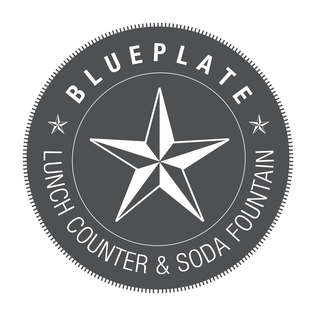
Blueplate Lunch Counter and Soda Fountain was a restaurant in Portland, Oregon, United States. Located in downtown's Dekum Building, the diner and lunch counter was established by chef–owner Jeff Reiter in 2006. The menu had American-style comfort food such as chicken and dumplings, French toast, meatloaf, and hot dogs, as well as banana splits, egg creams, milkshakes, and sundaes.
